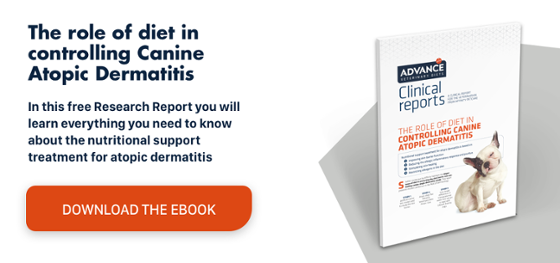Atopy in dogs: is a veterinary diet effective?
Atopy is one of the most common dermatological problems in dogs. According to a study published in Veterinary Immunology and Immunopathology1 it is estimated to affect 10–15% of all dogs. Although there is no cure, the clinical signs can be controlled with appropriate treatment, including the use of medications, such as prednisone, oclacitinib or cyclosporine, and support measures including management of any secondary infections by ecto- and endoparasites, frequent baths and an antigen-limited diet.
Atopy in dogs: mechanisms
Atopic dermatitis accounts for around half of all cases of canine dermatology. It is an allergic inflammatory skin disease with a genetic predisposition. The underlying mechanisms are:
- Hypersensitivity to environmental allergens. Dogs react to percutaneous or mucosal contact with allergens, usually mites, but pollen, fungi and insects can also provoke an allergic response. This contact triggers a humoural immune response involving the production of allergen-specific IgE antibodies.
- Altered skin barrier. Atopy in dogs is a consequence of changes in the skin’s insulating function, whether of a genetic or acquired origin, due to the mutation of a protein called filaggrin, which is one of the essential constituents of the epidermal barrier. This dysfunction of the cutaneous barrier allows the passage of allergens and aggravates transepidermal water loss, which causes the xerosis characteristic of atopic dermatitis.
Efficacy of diets to treat atopy in dogs
The typical treatment for dogs with atopic dermatitis includes oral antipruritic drugs, allergen-specific immunotherapy and topical treatment, but diet has been gaining an increasingly prominent role, especially as it has been observed that the problem is sometimes triggered by an ingredient found in the diet.
A study conducted by Glos K et al.2 in 50 dogs with atopic dermatitis showed that an atopy-specific hypoallergenic veterinary food for 8 weeks was an effective alternative as it reduced the clinical signs.
Another study3 involving 25 dogs diagnosed with atopic dermatitis analysed the effects of diet on the disease. All dogs received an initial dose of cortisone of 0.5 mg/kg/day, then half followed a commercial maintenance diet and the other half were fed with ADVANCE Veterinary Diets ATOPIC.
Researchers found that from day 28 to the end of the study on day 56, the CADESI-03 score, which measures the severity of lesions, was significantly lower for the dogs following the specific veterinary diet. There was also a reduction in the level of owner-assessed pruritus, which was significantly lower in dogs following the ATOPIC diet.
Finally, the total dose of cortisone given to dogs in the ATOPIC group was significantly lower (13.63 mg/kg) than the dose given to the control group (22.61 mg/kg). By the end of the study, none of the dogs in the ATOPIC group were receiving cortisone, whereas 8 out of 11 dogs in the control group were still being treated with cortisone.
In fact, ATOPIC and ATOPIC RABBIT have been specifically designed to relieve the clinical signs of atopic dermatitis, which affects the lipids in the stratum corneum, promoting the entry of allergens and skin dehydration. Affinity developed an artificial canine skin model to test nutrients that strengthen the skin barrier, such as aloe vera, before including them in our diets.
So, we formulated the optimal antigen-limited diet that helps significantly reduce the clinical signs of atopic dermatitis, improving the animal’s quality of life and, in some cases, even leading to the elimination or reduction of the medication.


